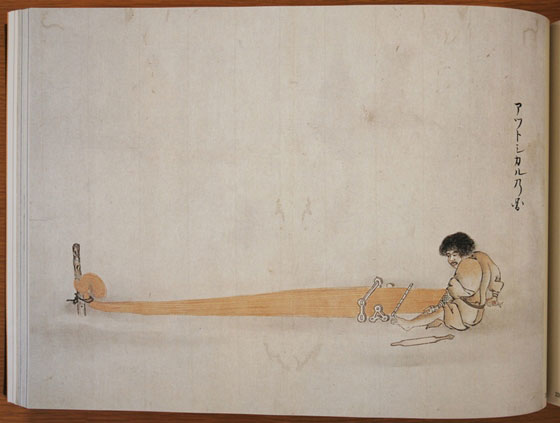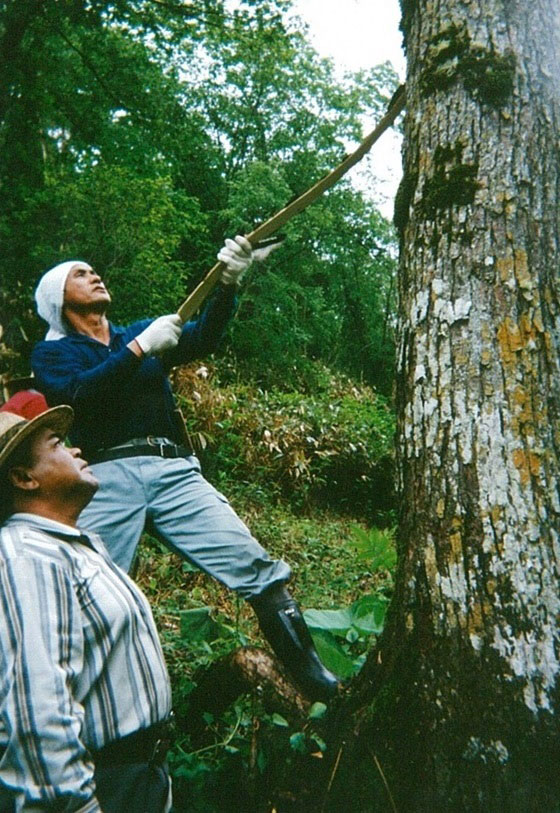 Photo:Nibutani folk handicraft association
Photo:Nibutani folk handicraft association
- Woven textiles
- Hokkaido
Nibutani bark cloth Nibutani attoushi
Plain colors and textures of Northern Japan
Ainu wisdom and harmony with Mother Nature
Description
What is Nibutani bark cloth ?
Nibutani Bark Cloth (called Nibutani-attushi in Japanese) is a bark fiber fabric produced in the region surrounding the the town of Biratori, Hokkaido. The term Nibutani originates from niputai which is an Ainu (indigenous people of north Japan) language word that means "a land where the trees grow thickly". Ainu people in the region still produce traditional crafts to maintain their cultural practices. The cloth has good breathability, water resistance, durability, and a distinctive texture. Threads spun from the inside layer fiber of wild Manchurian elms growing around the Saru River are woven with a weaving machine called attushi karape. This weaving machine has a unique shape where one end is fixed to a pillar or a leg of a table, while the other side is fixed around the weaver’s waist, and the weaver uses his body to pull the threads. Nibutani-attushi has been produced with almost the same tools and techniques for more than one hundred years. The fabric is used for making kimono, hanten (short coats), aprons, belts and accessories. It was originally used to make durable clothing for family members. However, its functionality and beauty were appreciated by Japanese merchants trading with the Ainu, and eventually Nibutani Bark Cloth was designated as a traditional craft.
History
 Photo:Nibutani folk handicraft association
Photo:Nibutani folk handicraft association
Ainu women have spun threads from tree bark fiber, and woven fabric to make durable clothing for their families for a very long time. As the Ainu had no written language, we can only know the history of the fabric from Japanese written documents. It is recorded in these documents that demand for Nibutani bark cloth increased in the latter half of the 18th century as trade between the Ainu and Japanese developed. According to a document recorded by the Abashiri City History Editing Committee in 1958, in the year 1792 “three rolls of attushi and two rolls of attushi with a hand length margin” were exchanged for “a bag of rice (approx. 14.4 liters)”. According to old documents, it seems that Ainu living inland with no access to marine products were developing crafts for trade. Craft trading companies increased the volume of purchases from the end of 1945, and when the folk craft boom occurred in the 1950s, production of Nibutani Bark Cloth became a local business. Men joined in the collection of tree bark, labor was divided into the spinning of threads and weaving, and they created a mass production system. Nibutani Bark Cloth, along with Nibutani Carved Trays, were designated by the Ministry of Economy, Trade and Industry as a traditional craft in March 2013. They were the first to be designated as a traditional craft in Hokkaido.
General Production Process
 Photo:Nibutani folk handicraft association
Photo:Nibutani folk handicraft association
- 1. Collecting tree bark
Although there is no rainy season in Hokkaido, as trees hold more moisture than usual in June making them easier to peel, bark from Manchurian Elms and Japanese Limes are collected in early summer. Manchurian Elms with branches 15 to 20 centimeters in diameter and with fewer joints are chosen. Using a hatchet, cuts are made 30 to 40 centimeters above the base of the tree; only the surface of the bark is cut, as it is important not to damage the wood part. Peeling is delicate work requiring both hands to lift the bark straight up with the aim of removing a 7 to 8 centimeter wide strip. The bark is worked free by twisting and shaking; the longer the strip the better, as longer and higher quality threads can be made.
- 2. Peeling the rough outer layer
The rough outer layer of the bark is peeled in the mountains, and the soft inner layer of the bark is taken home as soon as possible to prevent drying. The bark is bent, and the rough outer layer is carefully and thoroughly peeled from the bent crack. Occasionally a hatchet is used to make it easier. The inner layer of the bark is folded and bundled with the same inner layer of bark.
- 3. Softening the bark
The collected inner layers of the bark are stretched and dried for two to three days; they can then be stored for many years by drying in this way. The dried inner layers of the bark are bundled in preparation for boiling with wood ash; this will soften the thinly layered inside layers and make it easier to separate. The bark is placed in boiling water, and just before it starts to boil again, wood ash is added. The pot is then covered with a lid and simmered for several hours, while thoroughly mixing to make sure the alkaline brew penetrates evenly into the bark.
- 4. Peeling the bark
The boiled and softened bark that has become a reddish brown color is washed thoroughly in running water to remove and any sliminess as slime weakens the threads. When the fiber layers come apart they are kneaded and peeled while being careful not to make the fiber too thin or uneven.
- 5. Drying
The fiber layers are hung outside on a pole or frame and left for about two weeks to dry in the sun. The sun takes out the reddish brown color and rain evens out the color.
- 6. Shredding the fiber
After drying, fibers are once again softened in water to make it easier to peel the inner layers as thin as possible so that each sheet becomes a single layer. Then each sheet of single layer fiber is shredded into 2 millimeter wide strips and is dried again.
- 7. Making a thread ball
The shredded fiber is lightly twisted and spun into one long thread; this is very time consuming and it is said that it takes almost a month to make one ball of thread.
- 8. Setting the warp threads on the loom
As the warp threads should be longer than the length of fabric, the work is mainly done outside on a windless day to prevent the thread from becoming entangled and to ensure even lengths. A stake is hammered into the ground to fix the part of the loom where the warp threads are set, and another stake is hammered in the ground to hold the threads on the opposite side. Threads are set by two people. One walks between the stakes feeding out the threads, and the other sets them on the loom. When this is finished, the warp threads are bundled at intervals of 70 to 90 centimeters. The stakes are then removed and this process is finished.
- 9. Weaving
Attushi karape is a kind of ancient loom called koshibata (backstrap loom). One end of the warp threads is fixed to a pillar or something similar and the other end is fixed to the loom and on the waist of the weaver. The weaver sits and puts a cloth on his waist and pulls the threads while weaving. The woven fabric is left on the floor and rolled up while the weaver continues to weave while moving forward.
Where to Buy & More Information
Biratori Ainu Bunka Joho Center
-
Address
-
Tel.+81-1457-2-3299
-
Business Hours9am to 5pm
-
Website
See more Woven textiles
- Nishijin brocade
- Yuki tsumugi silk
- Kurume traditional resist-dyed textiles
- Ojiya chijimi textiles
- Hakata brocade
- Ushikubi tsumugi silk
- Chichibu-meisen silk
- Miyako ramie textile
- Shiozawa tsumugi silk
- Kumejima tsumugi silk
- Omi ramie cloth
- Ryukyu traditional resist-dyed textiles
- Kiryu brocade
- Murayama-oshima tsumugi silk
- Yumihama traditional resist-dyed textiles
- Chibana-hanaori textiles
- Hon-shiozawa silk
- Oitama tsumugi silk
- Ojiya tsumugi silk
- Yaeyama cotton cloth
- Yaeyama ramie cloth
- Honba oshima tsumugi silk
- Shinshu tsumugi silk
- Shuri brocade
- Tama brocade
- Yomitanzan-hanaori textiles
- Isesaki traditional resist-dyed textiles
- Hachio island silk
- Nibutani bark cloth
- Uetsu tilia bark cloth
- Awa-shijira cotton cloth
- Kijoka banana fiber cloth
- Tokamachi traditional resist-dyed textiles
- Tokamachi akashi chijimi textiles
- Yonaguni brocade
- Yuntanza minsa
- Flower pattern textiles
- Oku-Aizu Showa Karamushi Textiles































































































































































































































































































